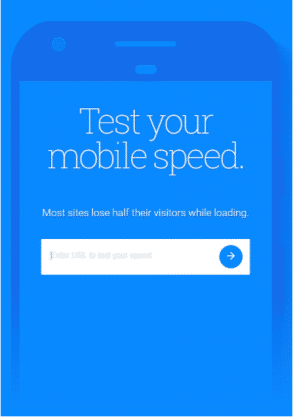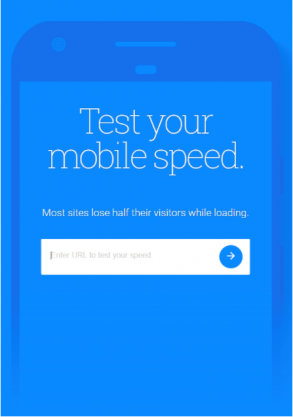Now more than ever, mobile site performance is extremely important. Read along to find out how the upcoming Google Speed Page Update will affect ranking factors including Quality Score and load time for mobile devices.
The majority of searches today are done on mobile devices. Therefore it is critical that your web site follows the fundamental parameters of load speed to make load quickly on any device.
Today’s Internet users expect everything to be fast. However, speed alone is not the only thing that matters, the users’ perception is also relevant.
When we analyze today’s internet users we must take into account their expectations about the web pages they visit. Most people don’t know or care what’s behind the website design. They mainly pay attention to ease of navigation and web page load speed.
In addition to obsessing over conversions, let’s examine why conversions from mobile devices might not convert as well as desktops. What could be inhibiting mobile conversions and what can we change so that the navigation and user experience help mobile users convert?
In 2018, Google tracked more than 900,000 landing pages on mobile websites in an attempt to understand their overall mobile performance. Google then determined what factors should be considered for users to have a great landing page experience.
The conclusions were alarming: it was discovered that 70% of web pages have a total download size that exceeds more than one megabyte (1 MB). This means that it is essential to make significant improvements in web pages to reduce this load.

One of the most important aspects of page optimization is reducing the size of images and text, as well as analyzing which elements (concatenated and minified javascript and cascading style sheets, using image sprites, using svg images, etc) can be modified to increase load speed and reduce page size.
Web pages that have fast load times and intuitive navigation, have lower bounce rates and improved conversion rates.
The average load time of a page optimized for mobile devices on a 4G network is 5.6 seconds.
Navigation speed depends on many factors, such as the type of mobile connection a user has at a given moment and the signal strength and connectivity of their mobile device. . Even though 4G connections are increasingly available in many countries, we can find ourselves in circumstances that affect the mobile device signal strength, such as a basement, a building or an isolated area with a poor signal.
It is recommended, from an user’s perspective, that a website load time takes of no more than 3 seconds, and from the same user perspective, a website which takes more than 10 seconds to load is discouraging and frustrating. All that unless there is a high enough interest for the user to wait for the page to load, otherwise it’s very likely that the visitor will leave before taking any meaningful action on your site.
As of July 1, 2018, Google will take into account the website load speed when calculating Quality Score in AdWords. Google will put a greater emphasis on the load speed as an indicator to determine ranking, so advertisers who are prepared or are in the process of adapting to this change will have a more favorable quality score than competitors who have not implemented mobile optimization strategies..
This is an excellent opportunity to motivate advertisers to optimize their websites for mobile devices.
In order to facilitate the evaluation of the load speed on websites, Google offers a free tool called “Test My Site” (https://testmysite.thinkwithgoogle.com/) which diagnoses the load speed of a particular web page on mobile devices and provides an estimate of the visitors that you may be losing if your site is slow. The tool also shows a comparative table of the performance of your site with respect to competitors and enables users to send the test results to an email address. The emailed report includes recommendations, suggestions, and a list of fundamental requirements for achieving an optimal result in load speeds.

Utilizing Google’s mobile speed tool is the first step you should take to verify if your website complies with Google’s suggested 3 second load time.
Additionally Google offers another more detailed tool for web programmers that analyzes and presents solutions to improve the load time of a website.
Page Speed Insights (https://developers.google.com/speed/pagespeed/insights/) is an excellent resource for improving both the desktop and mobile versions of your site.
The following is a list of suggestions that that can help improve page load speed:
- Reduce large image sizes. Formatting and compressing images correctly can save a large amount of data bytes, sometimes more than 50%.
- Reduce the server response time. There are several possible factors that can affect server response time. Among them: slow queries to the database, slow routing, slow backend library files, lack of processing resources or memory shortage.
- Prioritize your most important content by moving it to the top half of the page.
- Take advantage of browser caching by sending header ETags and Cache-Control.
- Remove the JavaScript that blocks the display and CSS of the content in the top half of the web page.
- Avoid redirects to landing pages.
- Enable compression. It is recommended that you enable “gzip” compression on your web server.
- Minify CSS, HTML and JavaScript: this involves the elimination of unnecessary or redundant data from a resource without affecting the way browsers process it. For example, delete comments and unnecessary formatting, remove unused code, use variables and shorter function names, etc.
Another excellent tool to verify and validate a website is Varvy SEO tool (https://varvy.com/) which offers a wide variety of evaluations, diagnostic results,and factors you can implement to achieve excellence in web design, one of them of course is website load speed.
Additionally Google’s Search Console (formerly Webmaster Tools) has a Mobile-Friendly Test available to users.
- In April 2015, Google began to consider ease of use in mobile devices as a global rating factor.
- In January 2016, the usability of a mobile website becomes one of the main guidelines of Google
- In February 2016, the AMP (Accelerated Mobile Pages Project) pages starts to be shown in the Google results.
- By May 2016, Google substantially increased the strength in ranking and indexing based on the friendliness of a website for mobile devices.
- As of July 1st of this year (2018) Google will take into account the loading speeds for the calculation of the Quality Score in Adwords, that is, Google will place a greater emphasis on the loading speed as an indicator to determine the ranking so that advertisers who are already prepared or are in the process of adapting to this change will be favored.
The main goals will be:
- Load time close to 3 seconds.
- Total web page weight not greater than 1Mb.
- Good navigability.
- Easier user experience to complete the conversion funnel: the fewer steps you have to complete, the more likely you are to convert.
This is an excellent opportunity to motivate advertisers to optimize their websites for mobile devices and CommonMind with their team of experts, we are here to help them.
Share this
You May Also Like
These Related Stories

How to Avoid Running Display Ads on Mobile Apps

Google’s Core Web Vitals Update: Here’s What You Need to Know
